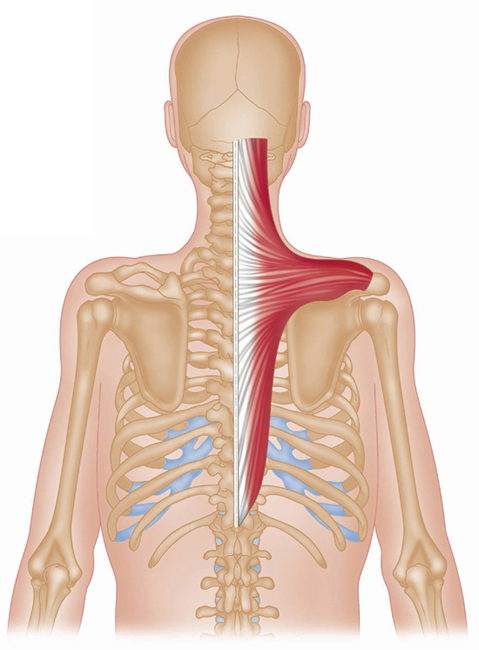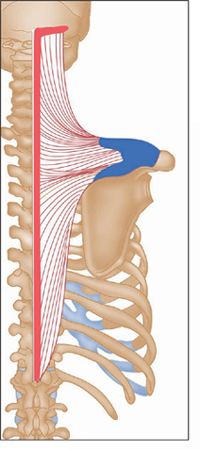Greek, trapezoides, table shaped. The left and right trapezius, viewed as a whole, create a trapezium in shape, thus giving this muscle its name. Origin Base of skull (occipital bone). Spinous processes of seventh cervical (C7) and all thoracic vertebrae, (T1–T12). Insertion Lateral third of clavicle. Acromion process. Spine of scapula. Action Upper fibres: Pull the shoulder girdle up (elevation). Helps prevent depression of the shoulder girdle when a weight is carried on the shoulder or in the hand. Middle fibres: Retract (adduct) scapula. Lower fibres: Depress scapula, particularly against resistance, as when using the hands to get up from a chair. Upper and lower fibres together: Rotate scapula, as in elevating the arm above the head. Nerve Accessory X1 nerve. Ventral ramus of cervical nerves, C2, 3, 4. Basic functional movement Example (upper and lower fibres working together): Painting a ceiling. Sports that heavily utilise this muscle Examples: Shot put. Boxing. Seated rowing. Common problems when muscle is chronically tight / shortened Upper fibres: Neck pain or stiffness, headaches. Strengthening exercises Shoulder press (upper fibres) Dips (middle/lower fibres) Chin-ups (middle/lower fibres) Lateral dumb-bell raises Self stretch Turn head to right and tuck chin in. Pull left shoulder down. Pull head and left shoulder apart from each other. Latin, levare; to lift; scapulae, shoulder, blade(s). Levator scapulae is deep to sternocleidomastoid and trapezius. It is named after its action of elevating the scapula. Origin Transverse processes of the first three or four cervical vertebrae, (C1–C4). Insertion Upper medial (vertebral) border of the scapula (i.e. portion above the spine of the scapula). Action Elevates scapula. Helps retract scapula. Helps bend neck laterally. Nerve Dorsal scapular nerve, C4, 5 and cervical nerves, C3, 4. Basic functional movement Carrying a heavy bag. Sports that heavily utilise this muscle Examples: Shot put. Weight lifting. Common problems when muscle is chronically tight / shortened Upper fibres: Neck pain or stiffness, headaches. Strengthening exercises Shrugs with dumb-bells or barbell Upright (vertical) rowing Self stretches Drop chin to chest and turn chin 45°. Keep spine long. Rhomboideus major runs parallel to, and is often continuous with, rhomboideus minor. Origin Spinous processes of the seventh cervical and upper five thoracic vertebrae, (C7–T1). Insertion Medial (vertebral) border of scapula. Action Retracts (adducts) scapula. Stabilizes scapula. Slightly assists in outer range of adduction of arm (i.e. from arm overhead to arm at shoulder level). Nerve Dorsal scapular nerve, C4, 5. Basic functional movement Pulling something towards you, such as opening a drawer. Sports that heavily utilise these muscles Examples: Archery. Seated rowing. Wind surfing. Racket sports. Common problems when muscles are tight or overstretched Tight: Soreness or aching between shoulder blades. Overstretched: Rounded shoulders are both symptomatic of, and exacerbated by, overstretched rhomboids (which tend to get overstretched rather than become too tight). Strengthening exercises Seated rowing Upright (vertical) rowing Lat. pull-downs Pulley shoulder adduction Self stretch Insertion on anterior of scapula. Lateral view. Latin, serratus, notched; anterior, before. The serratus anterior forms the medial wall of the axilla, along with the upper five ribs. It is a large muscle composed of a series of finger-like slips. The lower slips interdigitate with the origin of the external oblique. Origin Outer surfaces and superior borders of upper eight or nine ribs, and the fascia covering their intercostal spaces. Insertion Anterior (costal) surface of the medial border of scapula and inferior angle of scapula. Action Protracts scapula (pulls it forward on the ribs and holds it closely into the chest wall). Rotates scapula for abduction and flexion of arm. Nerve Long thoracic nerve, C5, 6, 7, 8. Basic functional movement Pushing or reaching forwards for something barely within reach. Sports that heavily utilise this muscle Examples: Boxing. Shot put. Common problems when muscle is weak ‘Winged scapula’ (looking like an angel’s wing), especially when holding a weight in front of the body. This is also a feature when the nerve to this muscle is damaged. Strengthening exercises Bench press (including inclined version) Shoulder press Press-ups Self stretch Latin, pectoralis, chest; minor, small. Pectoralis minor is a flat triangular muscle lying posterior to, and concealed by, pectoralis major. Along with pectoralis major, it forms the anterior wall of the axilla. Origin Outer surfaces of third, fourth and fifth ribs and fascia of the corresponding intercostal spaces. Insertion Corocoid process of scapula. Action Draws scapula forward and downward. Raises ribs during forced inspiration (i.e. it is an accessory muscle of inspiration, if the scapula is stabilized by the rhomboids and trapezius). Nerve Medial pectoral nerve with fibres from a communicating branch of the lateral pectoral nerve, C(6), 7, 8, T1. Basic functional movement Example: Pushing on arms of chair to stand up. Sports that heavily utilise this muscle Racket sports, e.g. tennis, badminton. Baseball pitching. Sprinting. Common problems when muscle is chronically tight / shortened Restricts expansion of chest. Strengthening exercises Bench press Dumb-bell flyes Pull-overs Self stretches Fix arm against a door frame. Step forward keeping your back lengthened, not arched. Raising or lowering arm will stretch different parts of the muscle. Latin, pectoralis, chest; major, large. Along with pectoralis minor, it forms the anterior wall of the axilla. Origin Clavicular head: Medial half or two-thirds of front of clavicle. Sternocostal portion: Sternum and adjacent upper six costal cartilages. Insertion Upper shaft of humerus. Action Adducts and medially rotates the humerus. Clavicular portion: Flexes and medially rotates the shoulder joint, and horizontally adducts the humerus towards the opposite shoulder. Sternocostal portion: Obliquely adducts the humerus towards the opposite hip. The pectoralis major is one of the main climbing muscles, pulling the body up to the fixed arm. Nerve Nerve to upper fibres: Lateral pectoral nerve, C5, 6, 7. Nerve to lower fibres: Lateral and medial pectoral nerves, C6, 7, 8, T1. Basic functional movement Clavicular portion: Brings arm forwards and across the body, as in applying deodorant to opposite armpit. Sternal portion: Pulling down from above, such as a rope in bell ringing. Sports that heavily utilise this muscle Examples: Racket sports such as tennis. Golf. Baseball pitching. Gymnastics (rings and high bar). Judo. Wrestling. Movements or injuries that may damage this muscle Indian wrestling and other strength activities that force medial rotation and adduction can damage the insertion of this muscle. Common problems when muscle is tight Rounds the back and restricts expansion of chest, restricting lateral rotation and abduction of the shoulder. Strengthening exercises










































![]()
Stay updated, free articles. Join our Telegram channel

Full access? Get Clinical Tree


Muscles of the Shoulder and Upper Arm






